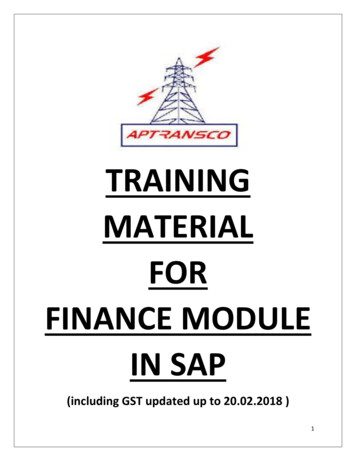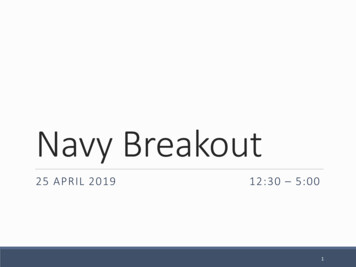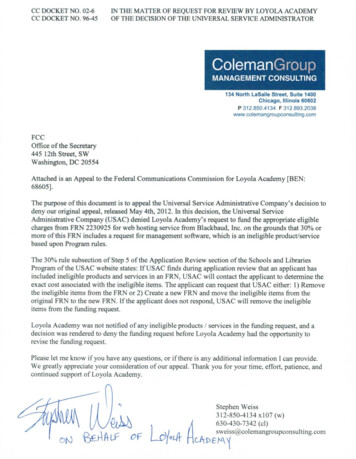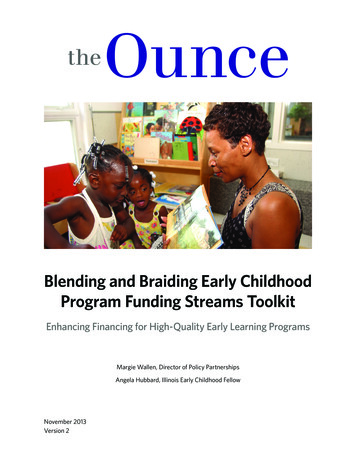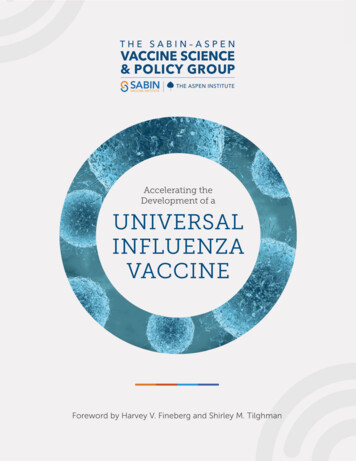
Transcription
Funding provided by:The Aspen Institute2300 N Street, N.W.Suite 700Washington, DC 20037Sabin Vaccine Institute2175 K Street, N.W.Suite 400Washington, DC 20037
ABOUT THE SABIN-ASPEN VACCINESCIENCE & POLICY GROUPThe Sabin-Aspen Vaccine Science & Policy Group brings together senior leaders acrossmany disciplines to examine some of the most challenging vaccine-related issues and driveimpactful change. Members are influential, creative, out-of-the-box thinkers who vigorouslyprobe a single topic each year and develop actionable recommendations to advanceinnovative ideas for the development, distribution, and use of vaccines, as well as evidencebased and cost-effective approaches to immunization.1
July 2019It is with great pleasure that we present the first annual report of the Sabin-Aspen Vaccine Science &Policy Group, which explores challenges and opportunities to develop a universal influenza vaccine.Here you will find a package of Big Ideas and supporting work, designed to overcome the scientific,financial, and organizational barriers to developing a vaccine that confers lifelong immunity againsteven the most catastrophic strains of influenza.The scope of that ambitious goal is matched only by the exceptional talent of the Vaccine Science& Policy Group, which convened for the first time in October 2018. Harvey V. Fineberg, president ofthe Gordon and Betty Moore Foundation, and Shirley M. Tilghman, president emerita of the universityand professor of molecular biology and public affairs at Princeton University, serve as co-chairs. The22 other accomplished members include science and policy experts and disruptors with experiencein government, industry, philanthropy, and advocacy on both the domestic and global front. We arefortunate to have the benefit of their collective wisdom and are grateful for the time and creativeenergy they have all dedicated to this work.We are also proud of the partnership between our two organizations, which has made this effortpossible. The Sabin Vaccine Institute is a leading advocate for supporting vaccine research anddevelopment, enabling access to vaccines and advancing knowledge and innovation in the field.The Aspen Institute, through its Health, Medicine and Society Program, builds on core principles ofrigorous non-partisanship and respect for evidence to tackle some of the nation’s most complexhealth problems.Recognizing the imperative of advancing vaccine science and policy, we saw that synergy was possibleby pairing Sabin’s scientific expertise and Aspen’s convening power. It only made sense to reinvigorateties that actually go back some 4 decades, when Dr. Albert B. Sabin, who brought the oral poliovaccine to the world, participated in Aspen Institute-sponsored programs. Both of our organizationshave track records of bringing together the sharpest minds across multiple disciplines to help societymove in bold new directions, and we are fully committed to continued collaboration.This inaugural report is the beginning of an undertaking that we believe can transform thedevelopment, distribution, and use of vaccines, and ultimately save millions of lives every year. We arehonored to have launched this initiative.Dan PorterfieldPresident and Chief Executive OfficerThe Aspen InstituteAmy FinanChief Executive OfficerSabin Vaccine Institute3
CO-CHAIRSHarvey V. FinebergPresidentGordon and Betty Moore FoundationShirley M. TilghmanPresident Emerita of the University andProfessor of Molecular Biology and PublicAffairs, Princeton UniversityMEMBERSAnn ArvinLucile Salter Packard Professor of Pediatrics(Infectious Disease) and Professor ofMicrobiology and Immunology,Stanford University School of Medicine;Vice Provost and Dean of Research Emeritus,Stanford UniversitySeth BerkleyChief Executive OfficerGavi, the Vaccine AllianceAlan BernsteinPresident and Chief Executive OfficerCanadian Institute for Advanced ResearchTanisha CarinoExecutive Director, FasterCuresMilken InstituteMichael ConwaySenior PartnerMcKinsey & CompanyKathryn EdwardsSarah H. Sell and Cornelius Vanderbilt Chair inPediatrics and Professor of PediatricsVanderbilt School of MedicineMark FeinbergPresident and Chief Executive OfficerInternational AIDS Vaccine Initiative (IAVI)Margaret HamburgForeign Secretary,National Academy of Medicine;Chair of the Board, American Association forthe Advancement of Science (AAAS)Penny HeatonChief Executive OfficerBill & Melinda Gates Medical Research InstituteRick KlausnerFounder and Chief Executive OfficerLyell ImmunopharmaSimon LevinJames S. McDonnell Distinguished UniversityProfessor in Ecology and Evolutionary Biology,Princeton University;Director, Center for BioComplexity, PrincetonEnvironmental Institute, Princeton UniversityDiego MirallesChief Executive OfficerVividion TherapeuticsKelly MooreAdjunct Associate Professor, Health Policy,Vanderbilt University Medical Center;Member, Advisory Committee on ImmunizationPractices (ACIP), Centers for Disease Controland Prevention (CDC)Katherine O’BrienDirector, Department of Immunization,Vaccines and BiologicalsWorld Health Organization (WHO)4
Muhammad PateGlobal Director, Health, Nutrition andPopulation Global Practice, World Bank;Director, Global Financing Facility for Women,Children and Adolescents, World Bank GroupHelen ReesFounder and Executive DirectorWits Reproductive Health and HIV InstituteUniversity of WitwatersrandLaura RileyChair of Obstetrics and Gynecology,Weill Cornell Medicine;Obstetrician and Gynecologist-in-Chief,New York Presbyterian HospitalGeorge SiberChief Scientific OfficerClearPath Development CompanyMichael SpecterStaff WriterThe New YorkerWendy TaylorRockefeller Foundation FellowThe Rockefeller FoundationRobert TepperCo-Founder and General PartnerThird Rock Ventures, LLCPardis SabetiProfessor, Center for Systems Biology andDepartment of Organismic and EvolutionaryBiology, Harvard University and Department ofImmunology and Infectious Disease,Harvard T.H. Chan School of Public Health;Member, Broad Institute of Harvard and MIT;Principal Investigator, Sabeti Lab, FAS Center forSystems Biology, Harvard UniversityPROJECT STAFFBruce GellinPresident, Global ImmunizationSabin Vaccine InstituteJamie MinchinAssociate, Global ImmunizationSabin Vaccine InstituteRuth KatzVice President and Executive DirectorHealth, Medicine and Society ProgramThe Aspen InstituteMargaret K. SaundersDeputy Editor, Global HealthHealth AffairsStacey KnoblerDirector, Influenza Vaccine InnovationSabin Vaccine InstituteKatya WanzerSenior Program AssociateHealth, Medicine and Society ProgramThe Aspen Institute5
6
CONTENTSF O R E W O R D .9Harvey V. Fineberg, M.D., Ph.D. and Shirley M. Tilghman, Ph.D.Co-Chairs, Sabin-Aspen Vaccine Science & Policy GroupPART 1SABIN-ASPEN VACCINE SCIENCE & POLICY GROUP REPORTAccelerating the Development of a Universal Influenza Vaccine.13PART 2FRAMING THE ISSUEInfluenza Vaccines and Scientific Priorities in the United States.37Michael SpecterPART 3BACKGROUND PAPERSRefueling the Innovation Engine in Vaccines.54Michael Conway, J.D., Adam Sabow, M.B.A., Jennifer Heller, Ph.D., Gila Vadnai-Tolub, M.B.A., andTara Azimi, M.P.P.Influenza Vaccination and the Vaccination Ecosystem.69Michael Watson, M.B.Ch.B., M.R.C.P., A.F.P.M.The Science and Coordination Challenges in Influenza Vaccine Development.94Heather Youngs, Ph.D.7
FOREWORDHarvey V. Fineberg, M.D., Ph.D.Co-ChairShirley M. Tilghman, Ph.D.Co-ChairFOREWORDVaccines are among the greatest global health achievements of all time. The World HealthOrganization estimates that immunizing children against diphtheria, tetanus, pertussis, andmeasles saves 2 million to 3 million lives every year. In the United States alone, these vaccineshave prevented more than 21 million hospitalizations and 732,000 deaths among childrenborn in the last 20 years, according to the Centers for Disease Control and Prevention.One of our most urgent needs is a vaccine that will protect the world’s people againstinfluenza — a vaccine that is safe and highly effective, a vaccine that works in the young andthe old and everyone between, a vaccine that is protective against any viral strain that mightarise, and a vaccine that confers lifelong immunity. The launch of the Sabin-Aspen VaccineScience & Policy Group (the Group) in 2018 coincided with the 100th anniversary of theworldwide Spanish influenza epidemic, which infected an estimated 500 million people andled to as many as 50 million deaths. In a more typical year, when the impact of the circulatingstrain of influenza is not so extraordinary, the virus still causes an estimated 290,000 to650,000 deaths worldwide, mostly in adults age 65 or older.9
FOREWORDAs co-chairs of the Group, we are convinced that the goal of attaining a universal influenzavaccine is a highly worthy pursuit. The bold, actionable recommendations we put forward inthis inaugural report are designed to communicate the urgent need, invigorate the necessaryresearch, and overcome admittedly daunting scientific and operational obstacles.The Group was formed to advance innovative ideas for harnessing the life-saving power ofvaccines in the U.S. and around the globe. Collectively, the leaders, thinkers, and practitionersamong this membership bring in-depth knowledge of vaccine-related scientific, medical, andpolitical challenges. To encourage cross-disciplinary dialogue, these experts are joined bytrailblazers in public health, regulatory science, philanthropy, venture capital, biotechnology,genetics, ecology, ethics, and journalism. We owe them our deepest thanks.In October 2018, members convened for thefirst time at the Aspen Institute campus inAspen, Colorado, to participate in two and ahalf days of thought-provoking conversationabout how best to speed the quest toward auniversal influenza vaccine. Their deliberationswere informed by the four commissionedThe bold, actionablerecommendations we putforward in this inaugural reportare designed to communicatethe urgent need, invigorate thenecessary research, and overcomeadmittedly daunting scientificand operational obstacles.white papers included in this compendium,written by some of the most knowledgeable people in the field.Armed with those and other rich resources, members looked for transformative Big Ideas.The package of ideas contained in this report is the result of that process. We expect todisseminate the report widely through the networks of the members of the Group as well asthose of both Aspen and Sabin.The Sabin-Aspen partnership behind this initiative is powerful and synergistic. Sabin iscommitted to advancing vaccine research and extending the full benefits of vaccines toall people, regardless of who they are or where they live. Sabin carries on the legacy of Dr.Albert B. Sabin, best known for creating the oral polio vaccine, which contributed to dramaticreductions in the burden of polio. The Health, Medicine and Society Program has a stellarreputation as a trusted, non-partisan player in the field of health care and health policy, andthe Aspen Institute, where it is housed, is widely known for its capacity to convene peoplefrom many disciplines and perspectives.10
FOREWORDIn addition to the Group’s members and the authors who participated in our inauguralmeeting, we are most grateful to Flu Lab — the Launch Funder of the Group — whichprovided support for this report and the research and other meetings that informed it. Thisimportant work simply would not have been possible without Flu Lab’s strong commitmentto efforts designed to accelerate the development of a universal influenza vaccine throughnew innovative ideas and cross-sector collaborations, in addition to and including thisprestigious Group.We also want to acknowledge the many contributions of staff from the Sabin and Aspenorganizations. Bruce Gellin, Stacey Knobler, and Jamie Minchin from Sabin and Ruth Katzand Katya Wanzer from Aspen all worked tirelessly together to help develop and manage thisnew initiative and our inaugural meeting. Finally, we want to recognize Margaret K. Saunders,deputy editor with Health Affairs, for her editorial work on the four commissioned papers andthis final report.It is tremendously rewarding for us to work with all of those so dedicated to driving vaccinedevelopment forward, and we eagerly anticipate our continued progress.11
12
Part 1SABIN-ASPEN VACCINE SCIENCE& POLICY GROUP REPORTAccelerating the Development of a Universal Influenza Vaccine13
CALL TO ACTIONCALL TO ACTIONInfluenza is a serious infectious disease, but there is considerable complacency about thethreat posed by this illness. What we casually refer to as “seasonal flu” is a recurrent epidemic.Every year influenza is transmitted from person to person, resulting in significant illness,hospitalizations, and death. Annual seasonal influenza is responsible for an estimated 3million to 5 million cases of mild to severe illness and between 300,000 and 650,000 deaths— with the true impact in low- and middle-income countries not fully appreciated becausesystems and infrastructure are not in place to accurately identify and track the disease(Iuliano et al., 2018).In Europe, influenza results in 4 million to 50 million symptomatic cases each year, and15,000 to 70,000 European citizens die every year as a consequence of influenza infection(European Centre for Disease Prevention and Control [ECDC], 2015).While there is considerable variability in the severity of influenza and the impacts onpopulations worldwide, in the U.S. during the 2017-2018 season, the more than 79,000deaths from influenza were greater than deaths from opioids and almost double the numberof deaths due to automobile accidents in 2017 (National Safety Council, 2018; Scholl,Seth, Kariisa, Wilson, & Baldwin, 2019; see Figure 1). The Centers for Disease Control andPrevention (CDC) reported that in the United States alone during the 2017-2018 influenzaseason, there were more than 48.8 million cases of influenza, more than 22.7 million medicalvisits, and 959,000 hospitalizations (CDC, 2018a).Figure 1: Number of deaths in the U.S. from influenza, opioid overdose, and motor vehicle accidentsSource: Based on data from the Centers for Disease Control and Prevention (2018a); National Safety Council (2018); and Scholl etal. (2019)14
CALL TO ACTIONThe primary means of preventing influenza infection and the morbidity and mortality itcauses is through an influenza vaccination, which is recommended annually. In manycountries that have influenza vaccination programs, complacency by the public and even byhealth care professionals may result in failure to recognize the true nature of the threat frominfluenza and low rates of vaccination coverage. Others are deterred by vaccine costs andthe difficulties of incorporating seasonal influenza vaccination targeting a wide age rangeinto already fragile immunization systems that are built for childhood vaccination schedules.In the U.S., despite the recommendation that everyone 6 months of age or older withoutmedical contraindications be vaccinated annually, vaccination rates are typically low. TheCDC estimates that during the 2017-2018 season, influenza vaccination coverage amongadults was about 37 percent, although coverage varied considerably by age and state. Thislow coverage rate also reflects a decrease in overall coverage of about six percentage pointsfrom the previous year (CDC, 2018b). Uptake of seasonal influenza vaccine in high-risk groupsin the World Health Organization (WHO) European Region is low and declining in severalEuropean Union (EU) countries (Navarro-Torné, Hanrahan, Kerstiëns, Aguar, & Matthiessen,2019).In addition to the inconvenience of gettingvaccinated, people forgo influenza vaccinesdue to the belief that influenza is a mild illness,the false perception of risks of severe sideeffects or acquiring influenza from the vaccine,and the failure to recognize the benefits ofimmunization often overshadowed by varyingIn many countries that haveinfluenza vaccination programs,complacency by the public andeven by health care professionalsmay result in failure to recognizethe true nature of the threatfrom influenza and low rates ofvaccination coverage.and suboptimal vaccine effectiveness. Eachof these issues has been highlighted as a barrier affecting influenza vaccine acceptance anddemand (Paules, Sullivan, Subbarao, & Fauci, 2018; Schmid, Rauber, Betsch, Lidolt, & Denker,2017). Despite the recommendation by the World Health Assembly for all countries to haveinfluenza vaccination policies and programs, there are wide disparities in influenza vaccine use(Global Burden of Disease, 2018; Ortiz et al., 2016; World Health Assembly, 2003). Only threeof the six global WHO regions1 accounted for about 95 percent of all influenza vaccine dosesdistributed in 2017 (Palache et al., 2017; see Figure 2).Beyond its significant annual toll as a recurring seasonal epidemic, influenza poses a uniqueand graver threat — the ability of the influenza virus to rapidly mutate and spark a pandemic.WHO Regional Office for the Americas/Pan American Health Organization (AMRO), WHO Regional Office for Europe (EURO),and WHO Regional Office for the Western Pacific (WPRO).115
CALL TO ACTIONFigure 2: Regional trends of seasonal influenza dose distribution per 1,000 population (by WHO region)Source: Palache (2018)Influenza poses a looming threat unlike almost any other natural disaster. Without warning,an entirely new strain of the virus may emerge to threaten an immunologically unprotectedhuman population and challenge our ability to design effective vaccines before theyare needed. The impacts of widespread illness and efforts to contain a pandemic couldoverwhelm health care systems, curtail and restrict global trade and travel, disrupt globalsupply chains of essential goods and local social services, and greatly increase school andwork absenteeism. A large-scale pandemic has the potential to cost the global economy upto 6 trillion (National Academy of Medicine, 2016), and simulations show that an estimated33 million people could die in the first 6 months of an outbreak (Institute for DiseaseModeling & Bill & Melinda Gates Foundation, 2018).16
CALL TO ACTIONThe year 2018 marked the centenary of the 1918 influenza pandemic estimated to haveinfected 500 million people and killed from 50 million to as many as 100 million peopleworldwide (Taubenberger & Morens, 2006). The ever-present threat of influenza —heightened by reminders of the epic toll of the 1918 pandemic — propelled the SabinAspen Vaccine Science & Policy Group (the Group) to examine the broad vaccine researchand development (R&D) enterprise and to identify current opportunities, challenges, andbarriers for the development and delivery of a universal influenza vaccine (UIV). To informrecommendations designed to drive impactful change, the Group probed the current state ofdiscovery and translational science, the structures and organization of R&D related to vaccines,and how funding and financing underwrite existing vaccines and promote the development ofnew vaccines.17
FRAMING THE CHALLENGEFRAMING THE CHALLENGEThe goal of developing and delivering a UIV — capable of eliminating the current threatsto the health and well-being of populations worldwide — is the driver behind the ideas andrecommendations included in this report. These proposed next steps — the Group’s Big Ideas— were informed by the extensive work to date led by governments, academic researchers,global industry and biotech firms, and philanthropists; these ideas seek to reinforce andextend this ongoing work and catalyze new work to achieve the breakthroughs that thus farhave been elusive.Selected recent advances reviewed by the Group and supported by governments, academia,and the private sector include: The National Institutes of Health’s National Institute of Allergy and Infectious Diseases(NIAID) 2018 strategic plan highlights its commitment to support the research needed toadvance the development of a UIV that provides long-lasting protection against multiplestrains of the virus for seasonal and potentially pandemic influenza (Erbelding et al., 2018).The strategy notes that ”advances in influenza virology, immunology, and vaccinologymake the development of a ‘universal’ influenza vaccine more feasible than a decade ago”(Erbelding et al., 2018, p. 347) due to efficiencies and insights in deep gene sequencingand advances in structural biology, among other scientific innovations. Through the Programme for Research and Technological Development and Horizon2020, the EU is supporting major initiatives to develop novel influenza vaccines throughimproving understanding of immunity against the influenza virus and immune responseto influenza vaccines; identifying genetic biomarkers that characterize highly pathogenicinfluenza strains; and using new immunization technologies, adjuvants, vectors anddelivery systems, formulations, and vaccination methods (Navarro-Torné et al., 2019).Philanthropic efforts are also taking an active role in catalyzing new thinking and approaches: Last year, the Bill & Melinda Gates Foundation launched a “Universal Influenza VaccineDevelopment Grand Challenge” with the goal of identifying “novel, transformativeconcepts that will lead to the development of universal influenza vaccines offeringprotection from morbidity and mortality caused by all subtypes of circulating andemerging (drifted and shifted) Influenza A subtype viruses and Influenza B lineageviruses for at least three to five years.” The 12 million Grand Challenge is seeking boldand innovative ideas, interdisciplinary collaboration outside of traditional influenza18
FRAMING THE CHALLENGEcommunities, and transformative approaches. Later this year, pilot grants of 250,000to 2 million will be awarded by the Foundation and Flu Lab, a new influenza-focusedcharitable organization, with the aim of starting clinical trials by 2021. Importantly, theGrand Challenge is intended for a vaccine that can be used in all age groups around theworld and especially in developing countries (Bill & Melinda Gates Foundation, 2018). The Wellcome Trust recently announced its support of the development of an influenzavaccines R&D roadmap to accelerate progress toward development of universal orbroadly protective influenza vaccines. The roadmap includes several objectives:document gaps and barriers in influenza vaccine R&D; identify achievable, realistic goalsand associated milestones with clearly defined timelines aimed at addressing gaps andbarriers; build consensus among a wide range of international stakeholders on keypriorities and strategies in influenza vaccine R&D; balance transformative and pragmaticchanges in vaccine technology to improve breadth and durability of protection frominfluenza infection and/or severe disease; stimulate informed investments in influenzavaccine R&D; and create a framework to enable tracking and monitoring of progress overtime (Plain, 2019).19
FRAMING THE CHALLENGEBeyond the important expansion of scientific understanding and increased funding tosupport the discovery and development of a UIV product, significant progress in expandingvaccine coverage and providing increased levels of vaccination assistance to low- andmiddle-income countries (LMICs) for new vaccine introduction and immunization systemdevelopment has been achieved over the past 15 years (Haakenstad et al., 2016). Theseinvestments (from national governments and multilateral organizations) and the healthsystems they support provide increasing opportunity to consider effective approaches forintroducing and expanding influenza vaccination in LMICs (WHO, 2019b). Additionally, WHO’srecently released global influenza strategy for 2019-30 includes a focus on strengtheningpandemic preparedness and response, including vaccination (WHO, 2019a). In many LMICs,a UIV — that is more broadly protective and provides a longer duration of immunity — wouldbe expected to be more cost-effective and logistically feasible for introduction into theseimmunization systems.To systematically review these existingactivities and the potential of these combined efforts, the Group commissionedfour white papers to illuminate the vaccineR&D landscape and examine how theseelements apply more specifically to influenza vaccines. The papers were designedto be complementary: to present thecomplexities and scope of the problem interms of the dangers of influenza; to analyze the scientific and structural challengesto and opportunities for innovation in reforming or reshaping the current research,development, and production system forinfluenza vaccines; and to consider potential solutions to create a more rapidly available andeffective influenza vaccine. These papers are compiled in Parts 2 and 3 of this report.20
PRINCIPAL FINDINGSPRINCIPAL FINDINGSThe world has arrived at a pivotal moment when innovative research using emerging toolsand technologies, together with a strategic approach toward development of a UIV, couldlead to a real breakthrough that has to date eluded past efforts. The convergence of new andrapidly progressing advances in the life sciences, manufacturing platform technologies, andcomputational sciences, applied to everything from protein structure to predictive algorithmsof vaccine efficacy, make the current moment a more promising time than ever to marshalresources toward the goal of dramatically reducing the threat of influenza. Nonetheless,many technical, scientific, and organizational challenges remain. Appreciating thesechallenges, the Group’s deliberations were shaped by the following principal findings:The threat of human disaster from influenza is great — yet this threat isunderappreciated and its timing unpredictable. We can no longer affordto delay in solving this urgent problem.The Group agreed that influenza poses a unique disease threat because it extracts a hightoll on human life year after year and also raises the specter of a truly catastrophic globalpandemic. Complacency about influenza is seriously misplaced — it is a worldwide problemthat requires a worldwide solution. At the same time, current approaches to R&D of influenzavaccines, while significant, do not respond effectively or adequately to this danger. Annualseasonal epidemics of influenza are far more serious than is widely recognized, and the riskof a global pandemic — although infrequent — poses an ominous threat.As revealed in our background papers and discussions, the pace of innovation in vaccinedevelopment generally has slowed over the past 5 years, with a flattening in the developmentpipeline, higher attrition for vaccines programs, and limited progress in meeting the vaccineneeds of many countries. Although there are substantial investments in basic research andvaccine development, R&D programs for influenza vaccines do not measure up to thescale of the problem. Current development of an annual vaccine based on tracking virusesand predicting which strains will prevail, then drawing on a predominantly egg-basedmanufacturing system, is utterly outdated. The persistence of outmoded technologies andreliance on often ineffective approaches (and the markets they sustain) have tended to deterfocused investment in a UIV. We need to adopt a new mindset that elevates development ofa UIV to the fast track.21
PRINCIPAL FINDINGSA universal influenza vaccine is a critical tool to eliminate influenzadisease and ensure lifelong protection from illness.Protecting the world’s population against influenza will require a transformational shiftin concept and execution, from reactive vaccine development and immunization againstannual influenza to a UIV that provides lifelong or multi-year protection against a broadspectrum of influenza strains. A successful universal vaccine would be safe and effectiveacross all populations, it would dramatically improve upon the current influenza vaccines interms of the breadth of protective efficacy and duration of protection, and most importantly,it would solve the problem of vaccine delay and lack of availability in the early stages of aglobal pandemic.Apart from a long-lasting, broad-spectrum, safe, and effective vaccine, two other criticaltools are wanting to cope with influenza. The first is more effective anti-viral drugs effectiveat all stages of acute illness. And the second is a field-ready and user-friendly diagnostictest to ascertain whether a patient actually has the disease; the goal is to improve our globalunderstanding of disease burden and efforts to prevent it.The process to develop a universal influenza vaccine should promotetransformational innovation.The current system for development and production of new influenza vaccines has not beenbroadly innovative. Change has been slow to come: vaccines have been manufactured thesame way for decades, and the science of immune protection remains uncertain and awaitsdiscovery informed by advancing progress and technology in the life sciences. A shift inemphasis from seasonal protection to lifelong protection will be disruptive, but it is the bestway to reduce the influenza threat. New scientific innovations show potential for openingnew lines of experimentation in vaccine development. Novel science comes with uncertainty,but the inadequacy of current influenza vaccines represents an assured risk. A new approachshould
innovative ideas for the development, distribution, and use of vaccines, as well as evidence- . have track records of bringing together the sharpest minds across multiple disciplines to help society . Vaccines are among the greatest global health achievements of all time. The World Health Organization estimates that immunizing children .


